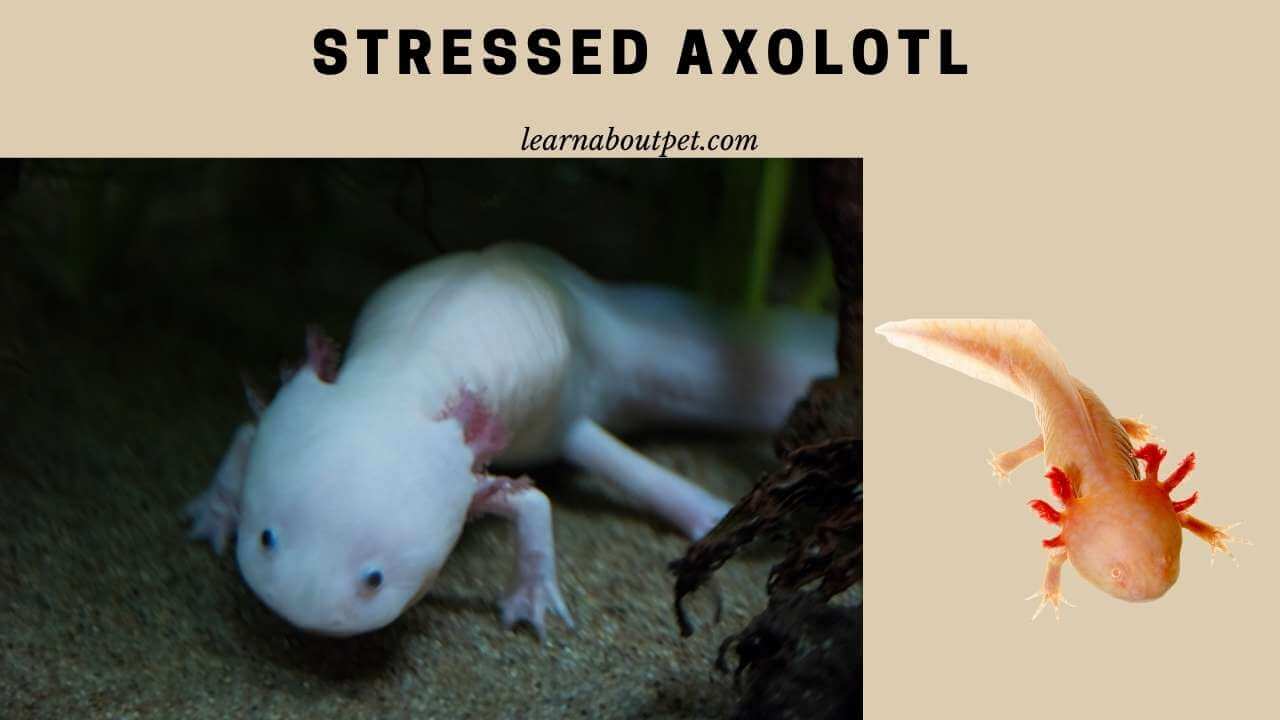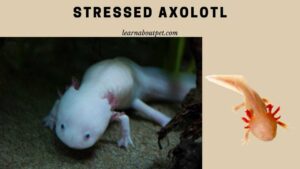Having an axolotl as a pet must be maintained so that it lives up to its life expectancy as a long-lived aquatic pet. There are many things that must be considered so that the axolotl stays healthy and has a happy life.
Stressed Axolotl do not reach the average life expectancy. The problems that axolotls most often experience and make them stressed and getting disease are too strong water flow from the filter in the tank and high temperatures. Other factors that cause axolotl stress include sudden temperature changes, foul water, parasites, untreated tap water, and tank mates.
To avoid some of the causes of a stressed axolotl, you must understand how to deal with it. We’ve listed some of the things you need to pay attention to when caring for an axolotl.

Can Axolotls Get Stressed?
Axolotls can be stressed just like humans if there are several factors that make them uncomfortable, and starting from that stress will cause disease to easily enter because of a decreased immune system.
Several signs can be seen when the axolotl is stressed, and will be seen from several parts of its body. Unhappy axolotls or stressed axolotl will have curled gills or curled tail tips. If there is curling at their tail, it indicates serious stress or illness.
Do not ignore the axolotl when experiencing this condition, so that they do not get worse and you can deal with the problems they are experiencing.
Letting axolotls stress will make it easier for them to get a disease and weaken their body condition. Of course you don’t want anything fatal to happen to the axolotl until you can’t help it anymore. Preventive measures are needed to maintain their health.
What Causes Axolotl Stress?
There are many things to consider when you have a stressed axolotl. One of the most common factors is if you have a filter in your tank, and the filter creates strong currents that cause axolotl stress.
Axolotls prefer to live in habitats with slow moving water and spend time at the bottom of the tank. If the tank has a strong current, the axolotl cannot swim calmly, and stresses them out.
You can add decorations from the tank such as rocks, large ornaments, live plants, to reduce the filter’s current. Or you can set the filter so that it doesn’t make the current too heavy.
In addition, axolotls can also be stressed due to inappropriate temperatures. Axolotl can only stay at cool temperature and not more than 22°C. They will overheat if the tank temperature is higher than that, and stress them out. If left too long, axolotl can get heat stroke.
You can provide an aquarium fan or water chiller so that the axolotl tank remains below 22°C. These two things happen most often, and you should always pay attention to the temperature in the tank or the water current.
Axolotls can also be stressed because there are other living things in the tank such as fish. Even axolotls can be annoyed by the presence of other axolotls in the same tank. If there is an axolotl with a larger size, it will disturb the smaller one, causing stress on the smaller axolotl.
You can leave the axolotl in the tank alone without having any tank mates. No need to worry, because axolotls will be more calm and comfortable when they are alone in the tank.
They will be more aggressive because of their predatory nature when there are fish or axolotls with a smaller size than them.
Do Axolotls Get Stressed Easily?
Axolotls are very easily stressed. Put the axolotl in a quiet place with a suitable size tank to provide the axolotl a safe environment from constant flashes of movement.
Stressed axolotl can be seen from the tank, whether the temperature in the tank is in accordance with the calm current or not. Water quality is the most important thing to keep the axolotl happy in the tank.
In addition, the axolotl will be more stressed if he is placed with tank mates. Axolotls are aggressive when they feel overcrowded, agitated, or hungry.
When you put a lot of small fish in the axolotl’s tank, he will get annoyed with the large number of small fish and can make them food because he feels disturbed.
In addition, if the axolotl is hungry and their diet is irregular, the axolotl is also more likely to get sick due to stress. For adult axolotls, it is recommended to eat every two to three days.
Leaving the axolotls alone in the tank will help you a lot, and all you have to do is think about maintaining the water quality and tank temperature for them. If you already know how to maintain water quality, you will be able to maintain their life expectancy.
How Do You Tell If Your Axolotl Is Stressed?
One of the most obvious signs of stressed axolotl is their gills. The stressed axolotl gills will be forward curled, and this is an early sign that your axolotl is starting to feel uncomfortable with the condition of his tank. Immediately find the problem, and fix it as fast as possible.
How do I know if my axolotl is stressed apart from the gills? I know of those who don’t want to eat even though they have been given live foods. Axolotls love to be fed live foods such as worms or crustaceans, as they need to chase their prey and grab them before they are swallowed.
Conditions when axolotl stress and illness are almost the same. If the axolotls are starting to get sick, they also have a curled tail tip that you can clearly see outside the tank.
If you can spot stressed axolotl such as cloudy water, drastic temperature fluctuations, or discomfort due to constipation, you need to consult a vet about this.
Immediately do an inspection for water level, temperature and axolotl behavior. If their gills return to normal, it’s a sign that your axolotl is no longer stressed.
How Do You Treat A Stressed Axolotl?
You can do several treatments on stressed axolotls such as salt bath, put them in a quarantine tub, fridging, or tea bath.
Quarantine tubs are one way to remove axolotls from tanks that are causing them stress. Until you find the problem, you need to put the axolotl in a tub that has calm water and the right temperature.
Check the ammonia or nitrate level in the tank and fix it immediately if a problem is detected. This can also be called healing for axolotls because for axolotls dirty water or the right temperature will make them easily stressed.
Stressed axolotl can also occur due to a fungus or infection from the scar. Immediately take the axolotl with care and do a salt bath for no more than 30 minutes. Mix salt and water with a size of about 6g/liter. You can use examination gloves to take fungus that is visible to you.

Fridging is not much different from putting axolotls in a quarantine tub, the difference is that you need the help of a fridge with a set temperature to keep the axolotls at a cool temperature until they can heal their bodies.
The tea bath is also almost the same as the salt bath, the difference is that the tea bath is only used for minor skin problems, and it is more effective if the axolotl does a salt bath. Both can reduce the stressed axolotl state.
Stressed Axolotl Symptoms
To recognize some of the conditions of a stressed axolotl, you must know some of the symptoms that they exhibit. The table below will show how the axolotl conditions when they are stressed.
| Symptoms | Explanation |
| Refusing to eat | The axolotl will eat less than usual, or won’t eat at all. Some of the causes can be from wrong temperature, high toxicity water, overcrowded, overfeeding, or constipation. |
| Gills falling off | Poor water conditions due to fungal or bacterial infections. Do a salt bath on the axolotl to handle it. |
| Floating | This could be due to impaction, high ammonia level, too many air bubbles being consumed. |
| Throwing up food | Often occurs due to overfeeding, or high ammonia levels. Make regular water cycles and choose a diet that is good for the axolotl. |
If the axolotl’s condition worsens after showing some of the above symptoms, you will see a stressed axolotl tail up and indicate that they are starting to get sick and getting worse. Immediately consult a vet so that you can do a suitable treatment for axolotl.
How To Help A Stressed Axolotl?
You can help axolotls not to get stressed easily by providing a supportive environment for them. If you have sufficient budget, you can make an axolotl tank by placing live plants, rocks for their hiding place, floating plants to keep the top of the aquarium, and several other aquarium accessories.
A water chiller or aquarium fan is perfect for reducing stress from axolotls who always need a cool temperature. Also install a water filter so that the tank has a suitable current and keeps the water level in a clean condition.
What to do if your axolotl is stressed? You can do a salt bath or leave them in the quarantine tub until problems are found with the axolotl. If the problem is in the axolotl body such as impaction or constipation, you should consult a vet to help with their condition.
If you have cleaned the tank and checked the water level, then put the axolotl back into the tank and see if their behavior is still stressed or is it better.
Axolotl Stressed In New Tank
It is common for a new axolotl to be stressed in a new environment. If you bring a juvenile axolotl from the pet store to your tank, of course the axolotl will react because it goes to a new place. It won’t be a big problem if the axolotl has the right tank and the right temperature.
Axolotl can be stressed because their new place uses tap water without going through the dechlorination process first.
Stressed axolotl will float when the water in their tank is not suitable, and occasionally they are like taking a breath on the tank surface because the water conditions can worsen their body condition.
How Do You Make Axolotl Less Stressed?
Axolotls will be less stressed if placed in a room that is not exposed to sunlight. You can give them a UV light that does not affect the heat in the tank so that the temperature remains stable.
The water level is always checked and the water changes regularly also make the axolotl feel at home in its tank.
For food, the axolotl is expected to be in accordance with their size and age, giving the axolotl time to digest the food completely.
Final Verdict On Stressed Axolotl
Having an axolotl as a pet has several challenges, such as maintaining the condition of the axolotl to become long-lived aquatic pets. Some ways that can be done are to avoid the condition of the axolotl to be exposed to stress.

Some of the things that make axolotls stressed are tank mates, wrong diet, bad water conditions, unstable temperatures. Axolotls are animals that live in cool temperatures, and they cannot be exposed to temperatures above 24°C to avoid heat stroke.
Axolotls are very sensitive to water conditions in the tank. If there is a certain level of ammonia or nitrate, the axolotl can stress and float.
Addressing some of the symptoms when axolotls are stressed will help owners to take quick action when their axolotls start to have curled gills or curled tail tips.

Welcome to Learn About Pet. My name is Rajkumar Ravichandran and I love all pets, travel, and amazing food. I write about my passion and personal experience caring for multiple pets in this blog! ❤️
Post Disclaimer
DISCLAIMER: THIS BLOG OR WEBSITE, "Learn About Pet", DOES NOT PROVIDE YOU WITH MEDICAL ADVICE AND IS NOT A SUBSTITUTE FOR MEDICAL ADVICE. ALWAYS GET IN TOUCH WITH YOUR PERSONAL VETERINARIAN AND USE INFORMATION HERE AS GENERAL ADVICE.
The information, including but not limited to, text, graphics, images and other material contained on this website are for informational purposes only. No material on this site is intended to be a substitute for professional veterinary advice, food recommendation, diagnosis, or treatment. Always seek the advice of your veterinarian or other qualified health care provider with any questions you may have regarding a medical condition or for pet food related questions.







